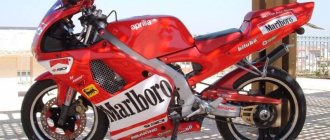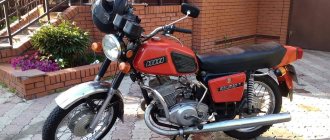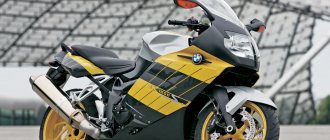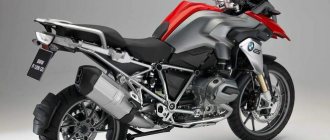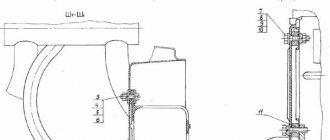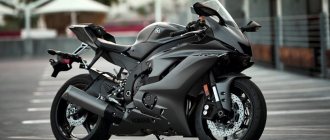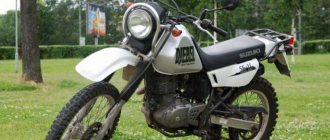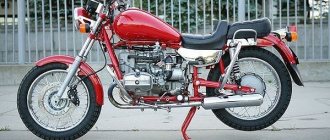Not all Soviet and Russian bikers have heard about the Voskhod 2M motorcycle, although most of them are well acquainted with the products of the Degtyarev Kovrov plant . The Voskhod series has a long past, starting in the mid-60s and ending in the 2000s, and the old 2M was released in the late 70s, that is, more than forty years ago. This was the third bike in the line, and despite the fact that it lasted only three years on the assembly line, it performed well, paving the way for subsequent models.
Design
The design profession did not exist in the USSR, and stern designers were guided mainly by considerations of practicality. Voskhod 2M was the result of their labors, which is clearly visible from the photo: square, angular, without a hint of any grace, a kind of hard worker, strong, but unprepossessing. However, given the age of the model, now its design does not play a role, since this motorcycle is valuable in itself due to its advanced age.
A short summary
So, the Voskhod 2 motorcycle is one of the best representatives of its time . A high-quality, reliable and economical vehicle has become a good option for driving both in the city and on the highway. But, despite its parameters that were quite good at that time, over time, 11 horses no longer became very relevant.
It will also be interesting: BMW motorcycles: timeless traditions in the motorcycle industry
As a result, the model began to lose ground. As a result, now such a bike is more of interest to fans of rare models, rather than being used as a work vehicle. On the other hand, you can always tune the motorcycle, but in the end there won’t be much left of the basic configuration.
Video review of the Voskhod 2 motorcycle:
Specifications
The hero of our review is simply a slightly modernized version of the previous model, without any fundamental changes. Compared to Voskhod 2, the motorcycle has become a little more powerful, with a modernized suspension, contactless ignition instead of cam and a fresher appearance. For the late 70s, its technical characteristics were quite good.
Engine
The 173.7cc single-cylinder, two-stroke, air-cooled engine dates back to the early 60s. For the Voskhod 2M, the battered engine was slightly upgraded, replacing the cylinder head and redesigning the oil channel layout, which led to an increase in its efficiency. Engine power was 14 hp. (compared to 10.5 hp for its predecessor, the Voskhod 2 motorcycle), and torque is 16 Nm . The maximum speed that a bike with this engine can reach is 105 km/h .
Transmission
a 4-speed gearbox excellent for its time , with a classic 1-N-2-3-4 scheme. From the very beginning of production of the model, improved discs were used in the clutch, making the operation of the box very precise. Moreover, even today, surviving examples that are in good condition demonstrate almost flawless operation of the gearbox.
Chassis and brakes
A standard steel frame made of ferrous metal and simple hydraulic shock absorbers - that’s all that can be said about the chassis of the Voskhod 2M. However, the designers took into account the deplorable state of most Soviet roads, and therefore slightly improved the suspension, increasing the fork travel and its diameter. If you don’t take a passenger on board, the suspension quite confidently absorbs nervousness even on rough rural dirt roads, at least if you don’t accelerate too quickly. And this is definitely not worth doing, given the primitive drum brakes on both wheels.
Electronics
The only noticeable difference between this model and the Voskhod 2 motorcycle was the introduction of contactless ignition. Otherwise, the electronic components did not change, but this bike was already equipped with full-fledged light optics, including turn indicators. The design does not include a battery.
Weight
The dry weight of the bike reaches 119 kg . This is a good 10 kg more than its predecessor, but still a modest figure. Subjectively, Voskhod 2M seems very light, it is easy to roll with your feet if necessary. However, ZiD motorcycles have always been compact and quite light, although they were usually classified as middle class and not light.
Controllability
This motorcycle was created for harsh Soviet conditions, and it handles rough roads confidently. Despite its unprepossessing appearance, Voskhod 2M takes to such situations like a duck to water! But on the highway it clearly lacks directional stability, since due to its low mass and short wheelbase it is noticeably “rearranged” by gusts of side wind.
Fuel consumption
The exact numbers directly depend on the condition of the particular instance. A motorcycle with a properly adjusted carburetor consumes about 4 liters per 100 km when driving on the highway and up to 5-5.5 in the combined cycle with a tank volume of 12 liters . It is no different in terms of efficiency, just like any other Soviet motorcycle.
Are there any disadvantages
But this bike also has several disadvantages. First of all, this concerns the appearance of the model. Looking at the photo of Voskhod 2, it becomes clear that you won’t show off such a vehicle to your friends (unless after styling). In addition, the bike’s frame is a little unsuitable for riding on dirt roads or roads with poor pavement (at the same time, the 2M model does not have this drawback).
Motorcycle price
Due to its prevalence and low demand, you can find this model on the secondary market. The cheapest copies start from 10-15 thousand rubles , but their technical condition usually leaves much to be desired, and there are often no documents. fully serviceable and well-restored bike will cost approximately 100-120 thousand rubles and more.
Technical features of the Voskhod 3M motorcycle
The main characteristics of the motorcycle include the following technical indicators:
- Ground clearance is 125 millimeters. This indicator makes it possible to operate a motorcycle on almost all types of roads (asphalt concrete, gravel, country roads, etc.).
- The length of the motorcycle is 200 centimeters, the width is 85 centimeters, and the height of the two-wheeled friend is 120 centimeters. Thanks to these parameters, two people can sit quite comfortably on the motorcycle.
- The mass of the two-wheeled vehicle is 122 kilograms. With a load of 160 kilograms, it retains its driving performance.
- The model is equipped with a single-cylinder two-stroke carburetor engine with a displacement of 173 cubic centimeters.
- The engine power is 15 l/s and the maximum speed is 105 kilometers per hour.
- Fuel consumption per hundred kilometers is 4.2 liters, which is 300 milliliters less than its predecessor.
- The fuel tank holds 14 liters of gasoline.
- The gearbox is four-speed, gear shifting is carried out using a special pedal.
- The motorcycle has a multi-disc clutch in an oil bath. The clutch is controlled using the right hand.
- The basis of the motorcycle frame is a metal pipe on which all components are located.
- The braking system is mechanical drum type, which reduces the overall weight and simplifies maintenance.
- The braking distance at a speed of 60 kilometers per hour is 20 meters, which is a fairly good indicator.
- There is an anti-theft system that operates by locking the steering wheel.
- Unlike its predecessor, the steering wheel of this model can change position, which makes the ride more comfortable for motorcyclists of almost any height.
- The power supply system runs on 12 volts and has a 65-watt generator. This together made it possible to install more modern lighting devices and improved engine starting.
- The suspension of the motorcycle is represented by a front telescopic fork and a rear pendulum system.
- The wheels of the model are spoked 16 inches in diameter.
- The headlight complied with modern European light transmission requirements.
Repair and tuning
These days, the Voskhod 2M motorcycle is somewhere in the middle between the concepts of “junk” and “rarity”. Therefore, some purchase it as an extremely cheap alternative to small-capacity “Chinese” ones, while others carefully restore their purchase and try to bring it to its original condition. The first approach is simple and cheap, but the second requires significant investments of labor and money.
Repair
Any person with a set of tools and hands growing from the place intended by nature, that is, from the shoulders, can repair the bike on their own. No, seriously - its design is extremely simple, there is practically nothing to break in it, and with proper care, Voskhod 2M can be inherited by great-grandchildren.
Spare parts
Collectors and restorers will encounter difficulties in finding original spare parts, since they will have to search for them long and hard, sometimes shelling out decent amounts of money for used pieces of hardware. But everyone else, who is not fixated on authenticity, will always find a way to attach a cheap Chinese carburetor or some part from a Voskhod of another model.
Tuning
Of course, during restoration to the “original” state, there can be no talk of any tuning. But among those who use the bike for its intended purpose, that is, for riding, the introduction of a battery into the on-board system is very popular. Initially, it was not provided for by the design, but everything can be solved, and besides, this solution allows you to make the operation of the electrical network more stable.
Negative qualities
The motorcycle also has some disadvantages, especially regarding its appearance - today at sunrise you can’t take 2 videos with spectacular stunts and you can’t brag to your friends.
In addition, this model had a slight unsuitability of the frame for traveling on bad roads or dirt roads (fortunately, this drawback was eliminated in the next modification of the motorcycle - Voskhod 2M). With the arrival of more powerful motorcycles on the Russian market, the motorcycle began to lack those same 10.5–11 liters. With.
In conclusion, it is worth saying that today the popularity of Voskhod 2 is observed mainly among connoisseurs of Soviet motorcycles . And no wonder! After all, now on the motorcycle market you can find a large amount of equipment that has both an impressive appearance and a more powerful engine.
In principle, some motorcycle enthusiasts manage to convert old Voskhod 2s into interesting and original equipment that meets all modern requirements, and also attracts the attention of even people indifferent to motorcycles. Although in this case, very rarely anything remains from the standard configuration of the motorcycle.
Frequently asked questions
- What about the interchangeability of spare parts from other Voskhods? Everything is fine with the interchangeability of spare parts; many things fit from other ZiD motorcycles. Some units can be picked up even from the latest models, “Owl” and “Courier”.
- Is it possible to install a 6V generator on it? The original is nowhere to be found. The nominal voltage of the standard generator is 7V, but 6V is also most likely suitable.
- Is it possible to find a copy with a side stroller? There are no original strollers for this model and never have been. However, sometimes you can find “collective farm” versions with strollers from “IZh” or “Java” on sale.
Intermediate stage between Voskhod-3M and the new ZDK family
Motorcycle Voskhod-3M-01
I think it’s no secret that putting a completely new model on the production line is quite a complicated matter. As a rule, it is necessary to purchase and install new equipment and reconstruct old production. It’s labor-intensive, expensive, and you also have to follow the plan. That is why most motorcycle and automobile factories are switching to new equipment gradually, step by step, introducing new components into serial production. This is how transitional models appear.
The presented “Voskhod-3M-01” is just such an intermediate step between the well-known “Voskhod-3M” and the new family of ZDK (we will introduce you to it later).
Owners of motorcycles from the Kovrov plant will be interested to learn about the design features of this motorcycle and the level of unification with previous models.
The main difference is the new engine. With the same working volume (175 cm3), its power increased to 10.7 kW, while the appetite was somewhat moderated. The crankcase, cylinder and its head have become different. The changes to the crankcase, however, did not affect the mounting points of the engine to the frame, so it can be installed on previous models - Voskhod-2, 2M, 3, 3M. True, this will require new exhaust noise mufflers (there is now only one) with an exhaust pipe and nuts and intake noise. If you install this engine on a model with 6-volt electrical equipment (2, 2M, 3), you will have to replace the 43.3701 or 80.3701 generator with the G-427. The generator seats are unified.
The area of the cooling fins on the new cylinder has been increased; they are located horizontally on the head. This reduced the thermal stress of the cylinder-piston group parts and reduced the noise level. Increasing the height of the cylinder made it possible to lengthen the purge channels. Now, moreover, there are five of them, and the blowing has improved.
To reduce fuel consumption and reduce the crankshaft speed corresponding to the maximum torque, a check plate valve is installed in the intake duct.
In the piston, the hole for the finger is shifted 7 mm upward, closer to the bottom, that is, to the center of gravity, which reduced knocking when “shifting” the piston at dead spots,
The remaining mechanisms: starting, gear shifting, clutch, and gearbox were taken entirely from the Voskhod-3M motorcycle engine.
The original part of the new engine is the crankshaft. Now its flywheels are made integral with the axles, this eliminates the possibility of the former turning relative to the latter (this sometimes happened before). All geometric dimensions remain unchanged, and it can be used on previous models.
Reducing the exhaust noise level is achieved through a new acoustic system, made, as usual, in the form of chambers and a resonant tube, which increase the path of exhaust gases and reduce their speed. To reduce the noise (by 1.5 dB) emitted by the muffler body, a double wall is installed in its front power part.
As for the parts of the chassis and carriage, the changes affected the front fender, the saddle, and some additional equipment appeared.
The plug is similar in its technical parameters and connecting dimensions to the old one. Only the traverse design became different. On the top there are two conical holes in which elastic bushings are located for suspension of the steering wheel. Such a crossbar, together with fastening elements, can be installed on the front fork of motorcycles starting from Voskhod-2M. To prevent the steering wheel from turning in the clamps, it is knurled, and a jumper is introduced to increase rigidity.
The Voskhod-3M-01 motorcycle will be produced with two versions of front guards: a serial steel one with movable pipes and a new plastic one. For the latter, another lower traverse is used, in which there are 4 holes for its fastening. This, in turn, required a fork stop welded to the front frame brace. The new stop allows you to install any version of the traverse (including those from previously released models). The use of a new crossbar together with a plastic front shield on the Voskhod-3, 3M motorcycles would require alteration of the fork stop. This is not recommended, since in this case damage to the front strut, the most loaded element of the frame, may occur.
To give the motorcycle a more modern appearance, the shape of the rear part of the saddle has been slightly changed.
The fairing, roll bars, and rear trunk can be installed on other models. The trunk will be available in two versions: with and without side shelves.
The motorcycle is equipped with a side stand. Those interested can buy the central stand of the Voskhod-ZM model and equip it with it on a new motorcycle themselves; the bracket on the frame is retained.
D. YUDIN, engineer
Conclusion
There is no point in chasing the 2-M model specifically, unless, of course, you are a rabid collector. Any other “Voskhod” is no worse suited for restoration and even for operation. Restoring a bike to 100% original won't be cheap, but if you repair it with other parts that are more readily available, it can be an inexpensive alternative for riding around the countryside.
Specifications
| Maximum engine power: | 14 HP |
| Working volume: | 173.7 cm3 |
| Motor type (cylinder arrangement, number of strokes): | 1-cylinder, 2-stroke |
| Number of cylinders: | 1 |
| Number of valves: | |
| Intake type (Injector / Carburetor): | |
| Bore and stroke: | |
| Starting system (Electric starter, kick starter): | |
| Maximum speed in km/h: | 105 km/h |
| Cooling system: | Air |
| Transmission (gearbox): | Mechanical 4-speed |
| Clutch (Dry / Wet): | |
| Drive unit: | Chain |
| Frame: | Tubular steel, welded |
| Chassis | |
| Suspension (front/rear travel): | |
| Brakes (Front/Rear): | |
| Wheels / Tires / Rubber: | |
| Dimensions and weight | |
| Dimensions (Length / Width): | |
| Seat height: | |
| Ground clearance: | |
| Curb weight: | |
| Wheelbase: | 1300 mm |
| Weight: | 119 kg |
| Fuel tank capacity: | 12 l. |
| Battery capacity: | |
| Year of release: | |
| Country of Origin: |
Moto-Kovrov
When creating a new motorcycle, the designers sought to rid it of the shortcomings of its predecessor, improve its technical and performance qualities and give it a more modern, attractive look.
And all this had to be done so that the new components and parts would fit the previous models. The new model increased the use of plastic parts, which reduced the weight of motorcycles and their cost.
Engine
Externally, the engine differed from the engine of the previous model with new clutch and ignition covers, as well as a new shape of the decorative cover that covered the carburetor - the latter was made of two parts for ease of installation.
A kickstarter with a folding foot was installed on the engine of export and exhibition samples.
The motorcycle featured a new gearbox with a large gear module and improved cams on the gears. As a result, the durability of the gearbox has been increased. It was guaranteed that in the highest fourth gear, the engine quickly accelerated the motorcycle to maximum speed from 35 km/h.
Changes also affected the exhaust system. The exhaust pipes have become shorter, and the muffler mounts have moved back.
Electrical equipment
The electrical equipment on Voskhod-2, as well as on previous models, was powered by an alternating current generator. The more powerful generator G-421 had four separate circuits.
The first served the ignition system, the second - the sound signal and the low and high beam lamps, the third - the brake light, the low beam lamp for the headlights, tail lights, and speedometer lights, the fourth - the direction indicator lights.
Thanks to this separation, the malfunction of one group of devices did not affect the operation of other groups.
The big advantage of the Voskhod-2 motorcycle is the presence of direction indicators. Two front and two rear lights are clearly visible from a fairly long distance both day and night. The rectangular housings of the “turn signals” were made by casting from an aluminum alloy and polished after machine processing. Inside the housing there was a lamp socket, a lamp and a spherical reflector plate, and the glass was fastened on top with two M4 screws. They were turned on by a switch located on the right side of the steering wheel. The direction indicator circuit included a special contact device - relay-breaker PE-421. To reduce the vibration and shaking of the motorcycle from affecting its operation, the relay was suspended in the right tool box on coil springs.
The new central electrical switch was equipped with a numbered lock and was located on the left side of the headlight. Three positions of the switch made it possible to turn on the ignition and lights sequentially, and an additional switch mounted on the left side of the steering wheel - low or high beam.
Stable operation of the circuit of side lights and speedometer illumination was ensured by the DR 100 throttle included in the circuit. For ease of installation of electrical wiring and direction indicators, a connecting block was provided, which was attached to the seat base.
On the first batches of Voskhod-2 motorcycles, the FP-230 rear light was installed, as on the Voskhod motorcycle; later a new FP-246 light of a more modern design was used, which was mounted on the rear wing using a stamped bracket.
Crew part
The crew section of Voskhod-2 underwent the greatest changes; this gave the motorcycle a new look.
The motorcycle was equipped with a headlight that had a hole on the left side for the central switch. The headlight kit also included a new SP-131 speedometer and a new wide rim without a visor.
The headlight was attached to the front fork casings, in the upper part of which there were rectangular windows, through the window of the left casing there was access to the ignition switch, and just below, the direction indicators were attached with M6 screws.
Some changes were made to the design of the front fork, in particular, to prevent the working mixture from flowing out through the breather holes in the plugs, bushings were used into which mixture deflector rods made of nylon were inserted. A support sleeve was placed over the spring, and the spring itself became shorter. The hydraulic shock absorber pipe was increased in length and had two pistons. The use of these parts has significantly improved the performance of the front fork.
The upper traverse was made of a steel forging and had a stepped shape in the plane; the steering wheel was attached to the top using an overlay shaped like an inverted trapezoid with four decorative M8 bolts. The hole for the fuel flap control cable was located in the middle of the right half of the steering wheel, and not in the center, as was the case on previous models. The steering column damper on the motorcycle was missing. The new high handlebar on the motorcycle ensured a comfortable riding position and reduced fatigue during long rides. As a result of installing a new steering wheel, the height of the motorcycle (without installing equipment) increased to 1090 mm, and the use of a new upper crossbar made it possible to extend the fork stays by 20 mm, causing the ground clearance to increase to 135 mm.
The new, less deep guard of the front wheel of Voskhod-2 received side stiffening ribs that prevented the appearance of cracks, and there were stampings in the front and back in the form of “eyelashes”. The struts of the front shield were stamped from sheet metal, and not from pipe as was the case on the previous model.
The rear shield also had stampings in the form of “eyelashes”, and a new reinforced, U-shaped license plate mounting bracket. On previous models, the bracket was a curved steel strip.
The shape and fastening of the fuel tank remained largely unchanged, only the fastening of the emblem was changed. The new round emblem with a running hare located in the center was made of transparent plastic, onto which black and mirror paint was applied on the reverse side, and the emblem was secured with two countersunk M3 screws. Nigrips with a new pattern were installed on the sides of the fuel tank. The tank was closed with a black carbolite lid with an image of a running hare at the top.
The trunk on Voskhod 2 was designed in an original way. It was a single unit with the seat base and was stamped together with it from the same blank. At the bottom of the trunk, two jumpers made of steel rod were attached to the sides, which served as an additional fastening for the rear mud flap. On export and exhibition samples, a handle was attached to the seat base on the left side, by holding which it was convenient to place the motorcycle on the center stand.
The “Kalabashka” intake noise silencer was made of nylon, and it was secured by rubber pipes connecting it to the carburetor and the air filter housing. The front of the “kalabashka” was covered by a middle closure made of black nylon. Tool boxes of a completely new design with removable lids were installed on the sides of the motorcycle. On export and exhibition samples, the lids of the tool boxes were not removable, but were opened using a hinge.
The role of tool box locks was performed by metal wing nuts with M10 threads with black plastic tips; on export and exhibition samples, the plastic tips were cream-colored. The wings were kept from falling out in the glove compartment lids by clamping washers. On the glove compartment covers of the first batches of motorcycles, a logo in the form of the inscription “Voskhod 2”, cast from TsAM alloy and coated with chrome, was fixed using clamping washers.
Later they began to use a logo of a different shape, and a recess appeared on the lid of the tool box. The plastic strip with the inscription “Voskhod-2” on the reverse side was covered with blue and mirror paint, and the strip was fastened with two aluminum rivets.
Below the glove compartments were lower closures made of black nylon. They were fastened with the help of passenger footrests and pendulum axle nuts, and the technological holes were closed with rubber plugs. On export and exhibition samples, the middle and lower closures were stamped from steel sheet.
The swingarm was changed, in particular the lower mounts of the rear shock absorbers. On the new motorcycle, the fastenings were cast as a separate part; on previous models, they were bent from a steel strip. The chain tensioners also became different. A stud with an M7 thread was welded to the L-shaped stamped bracket. The tensioner studs passed through holes in the lower part of the rear shock absorber mounts, threaded in the direction of travel of the motorcycle. Adjustment was made, as on previous models, with nuts. The parts were more difficult to manufacture and did not cope well with their functions.
The center stand was also cast from aluminum alloy, but the lower stand bridge was located higher, this minor change added stability to the motorcycle.
On the front brace of the frame, closer to the steering column, a U-shaped part with a hole for attaching the upper bracket of the knee pads was welded, the lower bracket was tightened with an engine mounting bolt. Knee mud guards were made of black nylon. On export and exhibition samples, the knee pads, like on the previous model, were metal and painted ivory.
The seat cover was cut in a new way and was used in two color options: black bottom, cream top, and black bottom and top. The wheel hubs had a different external pattern.
Bolts, nuts, washers, axles, brake rods and chain tensioners have been galvanized. Cadmium plating followed by chrome plating gave these parts a yellow color.
The following were covered with chrome: wheel rims, decorative covers of both wheels, exhaust pipes and exhaust pipe nuts, mufflers, movable pipes of the front fork, passenger footrests, decorative rear shock absorber cups, foot brake lever, gear shift and kickstarter levers, front and rear brake base levers, brackets and jumpers for attaching the rear shield, seat base, upper cross member of the front fork, plugs for the main fork pipes and steering column rod nuts,
steering wheel, steering wheel trim and bolts, decompressor bracket and lever, front brake bracket and lever, clutch control bracket and lever, carburetor enrichment shifter parts, throttle control parts, rear view mirror mounting bolt and parts, center shift decorative nut, rim headlights
The front and rear mud flaps, frame, swingarm, tool boxes with lids, fuel tank, lower cross member and front fork covers, knee pad mounts and side support were painted with enamels. Frames, swingarms, casings and lower crossmembers of the front fork were often assembled in black. The motorcycle headlight was supplied by a related company already painted black. On export and exhibition models, the headlight and direction indicators were painted in the color of the motorcycle, and the middle and lower covers were painted in ivory.
Voskhod-2 motorcycles were painted on an automatic paint production line in black, blue, red, light green, cherry, blue and yellow. The engine and carburetor cover were painted silver. On export and exhibition samples, engine parts, wheel hubs, chain guards, the base of the front brake pads and the central stand were phosphated and painted with silver heat-drying enamel.
A windshield was used as additional equipment on the motorcycle, which was sold separately to consumers. The upper part of the windshield was made of organic glass, the lower part was made of plastic. Thanks to this change, when the motorcycle fell, taking the blow upon itself, the lower part of the shield only deformed and protected the fragile plexiglass from destruction. The windshield mount remains unchanged. The production of new wind shields was short-lived due to the high cost of production, and shields of the previous design began to go on sale again.
The exhibition and export motorcycles, assembled on a separate assembly line, differed significantly in the quality of finishing of the parts. All parts were painted in a separate area by hand, and after inspection by the quality control department, a personal mark was placed. The chrome parts had a three-layer coating followed by polishing.
In the summer of 1972, a motorcycle rally in honor of the 50th anniversary of the founding of the USSR started on Victory Square. Ten Komsomol members of the plant set off on their motorcycles along the route Kovrov - Moscow - Krasnodon - Voronezh - Moscow - Kovrov. In a month they raced along the roads of Russia, Belarus, Ukraine, Georgia, and Armenia. Kovrov motorcyclists glorified the friendship of peoples, demonstrated the endurance and reliability of the products of their people.
On the basis of the Voskhod-2 motorcycle, a motorcycle for playing motorball was designed in the early 70s, and in 1973, the factory motorball team “Kovrovets” was created, whose coach was V.I. Tolokonnikov.
In December 1973, the production of Voskhod-2 motorcycles was planned in Syria; for this, a contract was concluded under which the plant was to supply motorcycles in disassembled form. The production of frames and stamped parts, as well as the application of paint and varnish, then the assembly of motorcycles was carried out at a Syrian enterprise.
The motorcycle was produced from 1970 to 1976. A total of 994,140 Voskhod-2 motorcycles were produced.
A well-preserved motorcycle in export version can be viewed in the private museum of Nikolai Tubaev.
Tuning options
Refinement of the design involves internal or external tuning. During internal modifications, the engine is rebuilt, driving parameters, suspension, and brakes are optimized. When external modifications are made, the motor vehicle is given a sporty style or it is converted into a chopper.
Features of internal tuning
Owners often rework the Voskhod-3M engine. To increase engine thrust, the factory paper air filter is replaced with foam filter elements. This helps reduce air exhaust friction. Then the jets and diffusers are polished using an abrasive material, the diameter of which affects the volume of fuel entering the engine.
To improve the fuel exhaust system, a new modernized carburetor is installed. From the existing pipe, take flanges for mounting on the cylinders, grind out aluminum bushings, and cut off the flange from the exhaust pipe. In an old carburetor, take a second flange. Using cold welding, the parts are connected.
The design is adjusted until it fits perfectly into the exhaust channels. Internal gaps are filled using epoxy glue.
Often rear adjustable shock absorbers are installed and sports tires are installed. When performing such tuning, the motorcycle becomes more aggressive and sporty.
Performing external tuning
In a sporty style
With a low seating position and a high front fork, there is a desire to modify the motorcycle in accordance with the sporty style. To do this, raise the rear shock absorbers and replace the exhaust pipe elbow. This way the exhaust pipe is level with the rear axle. Exhaust pipes with a larger diameter will improve the design and increase the traction of the bike.
External modifications can include painting, chrome plating, installation of nickel-plated arches instead of the old factory protection, installation of large rear-view mirrors, stepped seats and wheel tuning.
At the end of the tuning, a sports fairing is installed.
Chopper
When performing tuning for a chopper, shortened rear shock absorbers are cut off or purchased. Thanks to this replacement, the rear of the motorcycle will be lowered by several centimeters. The rear fork and wheel are replaced with wider ones. The angle of inclination of the front fork axis is replaced, and the cylinder covers are equipped with chrome plated cups. The same style is followed when tuning the headlights, rear lights, and dashboard.
Tuning for Cafe-bike
With such a modification, to reduce costs, they weld the rear part of the frame with their own hands, shorten the fork, trim and adjust other parts. For the steering wheel and seat, your own strength may also be sufficient. A headlight with a brake light is installed from trucks.
Most owners can carry out tuning on their own using only purchased parts due to the simplicity of the designs and the low cost of spare parts.
Technical characteristics of the motorcycle sunrise - 2 m data for adjustment and control
Ignition timing to TDC - 2.5-3.0 mm Gap between spark plug electrodes - 0.6-0.7 mm Gap between coil core and sensor magnet - 0.3±0.05 Tire pressure: front wheel - 1, 5 kgf/cm rear wheel - 2 kgf/cm Free play of the clutch lever - 5-10 mm at the end of the lever Free play of the handbrake lever - 5-10 mm at the end of the lever Free play of the throttle and corrector cable - 1-2 mm Free play of the pedal foot brake - 10-15 mm at the end of the pedal Sagging of the upper branch of the chain at a distance of 75 mm from the center of the axis of the drive gear when pressed with a force of 2 kgf - 20 mm
Source
Technical characteristics of the motorcycle Voskhod - 2 m power transmission
Clutch - multi-disc in an oil bath with the number of disks: driving (plastic) - 7, driven (metal) - 8 Clutch control - manual Gearbox - two-way, four-speed Gear shift - foot Transmission from engine to clutch - bush-roller chain PV 9.525- 1100-44 links Engine-clutch ratio - 2.07 Transmission from gearbox to rear wheel - bush-roller chain PR-12.7-1800-2 Gearbox - rear wheel ratio - 2.93 General gear ratios in the box gears: in 1st gear - 3.04 in 2nd gear - 1.993 in 3rd gear - 1.482 in 4th gear - 1 (direct) General gear ratios (from engine to rear wheel): in 1st gear - 18.42 in 2nd gear - 12 .08 in 3rd gear - 8.98 in 4th gear - 6.06


